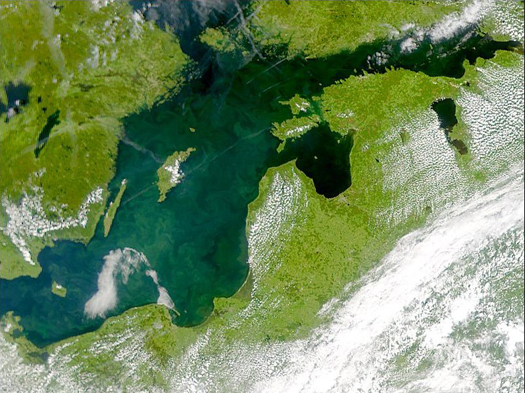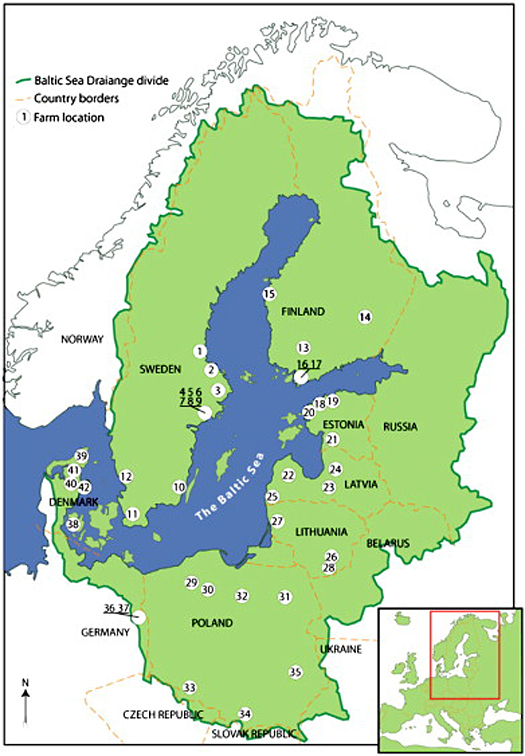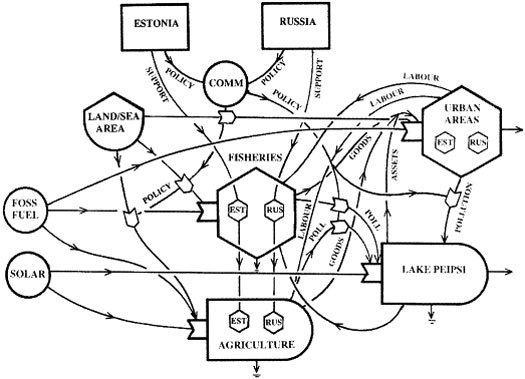
The Baltic Sea. Photo: NASA
The map below is of the Baltic Sea. Over the last hundred years its ecosystems have been poisoned almost to death by outputs from a multitude of industries and farming activities in the nine countries that surround it. These deadly flows are shown on the complicated chart beneath.


Numerous action plans that address individual elements of the problem have been launched in recent decades – but progress in restoring Baltic ecosystems has been modest at best. What’s really needed is a way for all the stakeholders involved – municipalities, farmers associations, research institutes- to collaborate around a shared objective: bringing the sea back to life.
The Baltic Sea is just one example of a challenge that crops up everywhere. Think about the food systems of a city; the restoration of a river; the management of informal waste economies; or the care of older people. In all such contexts, a variety of different actors and stakeholders – formal and informal, big and small – need to to work together.
The lesson everywhere is the same: Good intentions on there own are not sufficient – something extra is needed. A workshop in Barcelona during the Informal Economy Symposium, on 12 and 13 October, will explore what that extra ‘something’ might be.
By way of background: At the Stockholm Resilience Institute, in Sweden, Per Olsson and Victor Galaz say we need to move away from quick technological fixes. Too many solutions that address sustainability are linear and single-problem oriented. To solve complex and interconnected human-environment challenges, we need to build ‘social-ecological coalitions’, or ‘constellations’.
Turning that insight into collective action is hard. Scientists tend to say: ”our job is to do research and present sound evidence; determining what to do with it is for others”. Mainstream media take a similar line: ”we report the news; we don’t make it”. Law makers believe themselves to be powerless, too: they often say that, “yes, something needs to be done – but voters will not tolerate being told to reduce their living standards”.
Confronted by that impasse, an awareness is growing that neither experts, nor governments, should even be expected to take care of ecosystems on their own. Jill Rutter, for example, co-author of Policy Making in the Real World, argues that “civil servants need to see their role not as sitting on top of a delivery chain, but as system stewards” (my emphasis).
Examples of stewardship approaches are rare, but they do exist.
In Brazil, they use the word ‘articulation’ to describe facilitation among sometimes large numbers of different stakeholders. In the Articulation in the Semi-Arid (ASA), for example, several hundred civil society and farmers’ organizations have been collaborating since 1999 on a programme called A Million Cisterns; its aim is to guarantee access to water for human consumption in rural households – and thereby slow down desertification of this vast region. Also in Brazil, nineteen social and civil society movements are working together in the National Agroecology Articulation.
Elsewhere in the global south, a process called ‘Multi Actor Ecosystem Participation’ has emerged from efforts to improve the governance of land, water, forests, and grasslands. In the Sahel region of Africa, for example, a reforestation system called Farmer Managed Natural Regeneration (FMNR) has been developed. A training programme has also been launched on “Facilitating multi-actor collaboration for sustainable resources management”.
Commons-based approaches are often present in the management of collective natural resources like forests and land and water in the South. For instance, all the forests in Nepal are managed by the communities who need the resources of the forests to make a living. And about 60% of the land and forest in Mexico, which is a huge country, are managed by Comunidades Agrarias, or the so-called ejidos which again is a commons-based way of reproduction of livelihoods. (For more on this see The Wealth of the Commons: A World Beyond Market & State, edited by David Bollier and Silke Helfrich).
Behind the arcane language, a profound transformation in approaches to design and development is discernable. We’re moving away from the design of of large-scale, hard-wired solutions, and towards a focus on resource ecologies and re-skilling. Various training programmes and next-generation institutes will teach you about adaptive resilience and how to do it.
At the Presencing Institute, for example, founder Otto Scharmer runs Theory U workshops around the world that teach people how to ‘co-sense and co-create positive change’. The Alia Institute, based in Halifax Nova Scotia, also offers skill-building courses with names like Change Lab, Human Systems Dynamics, and Appreciative Inquiry. Rather than deliver a pre-packaged toolbox, the Alia Institute shows people how and when to use particular methods from the many that are out there. Another network, Art of Hosting, teaches people ‘how be successful in complex circumstances when we can’t predict what ten, five or even two years down the road will look like’.
The Elos Institute in Brazil, founded in 2000 by young architects, runs a collaborative game called Oasis that’s designed ‘to awake and give impulse to communities through fast actions with high impact’. A cross between an architectural charette and an Amish-style barn-raising, Oasis games typically end with a a square, a park, a day care center or a cultural centre being built there-and-then.
These approaches clearly meet a need – but their reach is limited. Their new-agey language is an obstacle to the participation people who could probably use need the skills they offer – for example, the city managers, farmers, and interested but not hyper-motivated citizens. (The most clearly-written accessible book on this emerging field is Resilience, why things bounce back. by Andrew Zolli and Ann Marie Healy).
The design task, which we’ll start at the workshop in Barcelona, is to bring together visions, ways of knowing, and ways of collaborating, that will make constellation management more accessible and easier to scale.

